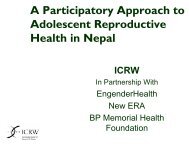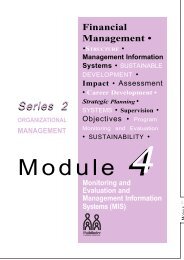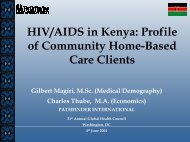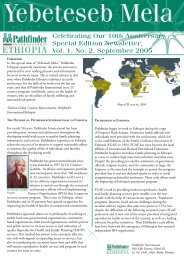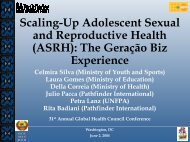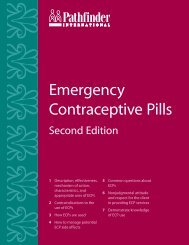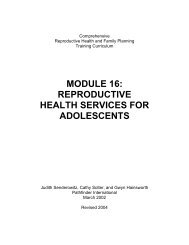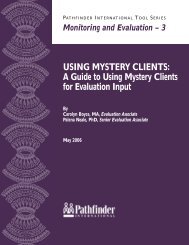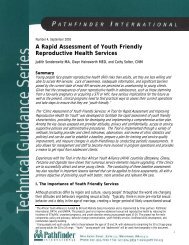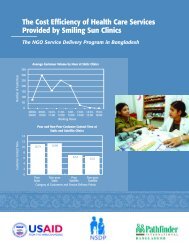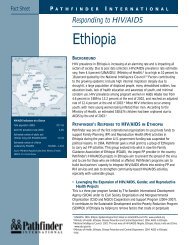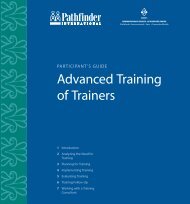Assessment of Youth-Friendly Postabortion Care Services:
Assessment of Youth-Friendly Postabortion Care Services:
Assessment of Youth-Friendly Postabortion Care Services:
- No tags were found...
Create successful ePaper yourself
Turn your PDF publications into a flip-book with our unique Google optimized e-Paper software.
important that assessors note any data that they collect in the response section. Only later will a specific score be assigned depending on thedegree to which the standard has been met (see bullet f below).4. Respect for youthclientSP, O, Y: Do providers show respectfor the adolescent PAC client duringtreatment, counseling, andconsultations? Do providers informclients that they don’t have toprovide information if it feels toosensitive? Do providers allow clientsto ask questions?Example: Providers said they treat youth with respect and allow them to ask questions.<strong>Youth</strong> clients/observation confirm that all clinic staff (receptionist, counselor,provider) treat the adolescent PAC client with respect and courtesy and allowclients time to ask questions.<strong>Youth</strong> clients/observation reveal that sometimes clinic staff do not treat youthwith respect and courtesy and allow clients time to ask questions OR staffreport they treat adolescents with respect, but this cannot be confirmed by clientinterviews or through observation.Clinic staff do not treat the adolescent PAC client with respect and courtesy andallow clients time to ask questions most <strong>of</strong> the time.210No youth clients werepresent so nointerviews orobservationsconducted.CARRYING OUT THE ASSESSMENT:The team should understand the nature <strong>of</strong> and time required for the assessment, which includes the following tasks:a. Arrangements must be made for the assessment visit. The assessment can take up to a full day, but a minimum <strong>of</strong> four hours. Besidesagreeing upon the date and time for the assessment, arrangements need to be made for all the interviews and observations.b. In advance, the team should familiarize itself with the elements to be assessed and discuss the definitions to make sure that all teammembers understand them. The team should also divide up the work. For example, two team members might be assigned to interviewthe facility administrator, while other team members interview youth clients. Take into account the routine <strong>of</strong> the service providers andtry to make data collection as unobtrusive as possible. Consider timing; which sections require clients, which sections can be completedwhen there are no clients? Be flexible; it may be impossible to complete the whole guide at one time. You may have to wait to observesome procedures.c. Before collecting the data, it is very important that the assessment team discuss the assessment objectives with facility staff andsupervisors. If possible, discuss this before the assessment, so all opportunities to observe PAC services can be utilized. The assessmentteam leader should explain clearly how and why the assessment will be done, emphasizing that the assessment guide is designed not t<strong>of</strong>ind fault, but to identify areas where improvements can be made.d. For each section, fill in the information requested. Use your judgment and ask other pertinent questions that may not be included in theassessment tool. Use the comments/recommendations column—these observations <strong>of</strong>ten provide very useful information.e. When the team has collected as much information as possible, the team should meet and make sure all information is recorded accuratelyand completely.Pathfinder International • <strong>Assessment</strong> <strong>of</strong> <strong>Youth</strong>-<strong>Friendly</strong> <strong>Postabortion</strong> <strong>Care</strong> <strong>Services</strong> 2



